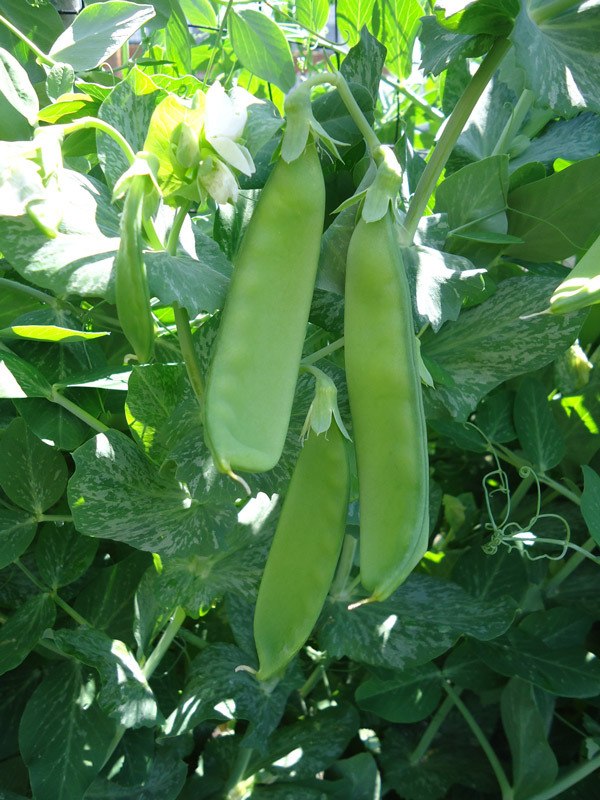For a crop that is well-suited to our climate, easy to grow and popular among all age groups, consider growing sugar snap peas in your garden this year.
Although peas have been cultivated for over a thousand years, sugar snap peas are a more recent arrival. Developed in the late 1970s, sugar snap peas are a hybrid of garden peas (sometimes called English or shell peas) and snow peas. Sugar snap peas differ from “their parents” in that they produce a round edible pod that is strikingly sweet whereas the pods of garden peas are inedible and those of snow peas, although edible, are flat and rarely considered sweet.
Snap peas, like all peas, thrive in cool, damp weather, making them an ideal crop for early spring planting. Because yields decrease as the days get longer, snap peas should be planted as early as possible after soil temperatures have warmed to at least 40 degrees.
Some gardeners soak the seeds in water overnight or “pre-sprout” them before planting to speed germination because the large seeds can rot in cold, wet soils. (See the May 4 “Get It Growing” column for steps for pre-sprouting seeds.)
Snap peas produce best in full sun and a well-drained soil that is rich in organic matter. Plant seeds about an inch deep and one to two inches apart. Thinning is generally not recommended.
Most varieties of snap peas need to be trellised. To avoid damaging the plants, erect the trellis prior to planting. A variety of materials can be used including netting, string or chicken wire stretched between sturdy upright supports or even a collection of twiggy branches stuck into the ground among the plants.
Because peas attach by tendrils, you only will need to guide your growing plants to the trellis and they will do the rest. But be gentle, pea plants can be fragile.
Make sure your peas receive about one inch of water each week; they do best when the soil is kept slightly moist, not dry or water-logged. Avoid wetting the leaves when you water which increases the risk of fungal diseases.
As members of the legume family, peas fix their own nitrogen from the air, so fertilizer rarely is needed. If the seedlings take on a yellowish tint, apply a balanced fertilizer (one with equal proportions of nitrogen, phosphorus and potassium by weight).
Before you know it, your peas will be ready for harvest. Pick snap peas when pods reach the expected length (3-4 inches) and are round and plump. Picking often stimulates the plant to bear more.
As the weather warms, your snap peas will peter out, often succumbing to powdery mildew. At this point, pull out the plants and replant the space with a warmth-loving crop.
Kids love picking peas and will eat them as they are harvested! For the peas that make it to the kitchen, they are a great raw in salads as well as lightly steamed and stir-fried.
If your family doesn’t get its fill of sugar snap peas from your spring planting, don’t worry! Snap peas can be planted as the weather cools again (six to eight weeks before the first frost date) for a delightful fall harvest.
Pearl of Wisdom
Pea tendrils and shoots also are edible if harvested when young.
Begin harvesting tendrils and shoots when plants are 6-8 inches tall.
Use as you would use edible pea pods in salads, on top of soups or lightly steamed or stir-fried.
Jeanette Stehr-Green is a WSU-certified Clallam County Master Gardener.
Sugar lime peas and carrots
— from The Essential Vegetarian Cookbook
Sugar snap peas are naturally low in saturated fat and cholesterol, but are a good source of vitamins A and C and fiber.
Ingredients:
1 large carrot
2 cups sugar snap peas, strings removed
¼ cup butter
2 cloves garlic, crushed
1 Tbsp. lime juice (and rind from one lime, to make zest for garnish) (if limes are not available, lemon juice and zest can be substituted)
½ tsp. soft brown sugar
Peel carrot and cut into thin diagonal slices. Heat butter in frying pan. Add garlic and cook over low heat for one minute. Add lime juice and sugar. Cook, stirring over low heat until sugar is completed dissolved. Add carrots and peas and cook over medium heat for two to three minutes or until just cooked. Serve hot. Garnish with lime zest. Makes four servings.


